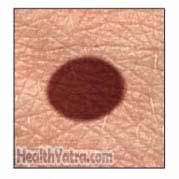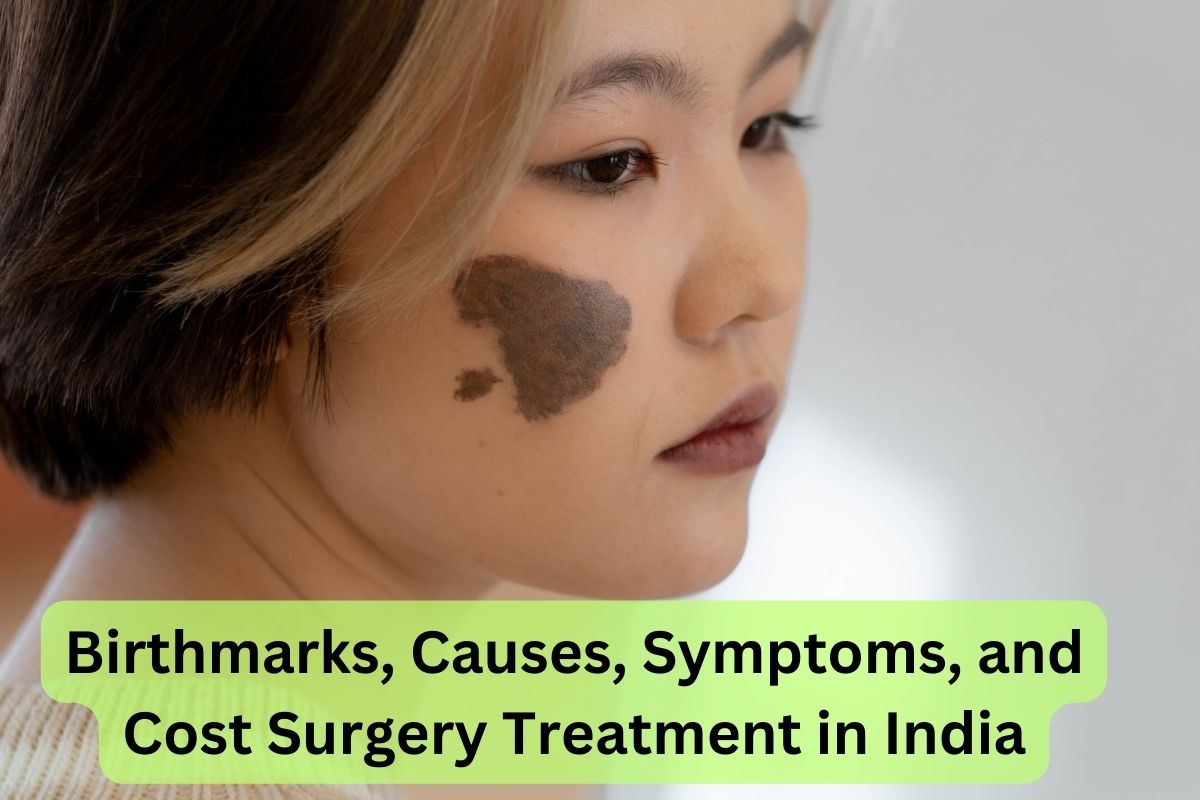تعريف
Birthmarks are colored spots on the skin that babies are born with or develop shortly after birth. More than 10 in 100 babies have birthmarks.
These marks can be bright red, pink, brown, tan, or bluish. Birthmarks can be flat on the surface of the skin or raised. Birthmarks are labeled by their colors and consistencies.
The most common type of birthmarks include:
Café-au-lait Spots
These are light tan colored spots. Having up to three such spots on your body is usually fine. Having more than three café-au-lait spots can possibly indicate a condition called neurofibromatosis. It is a genetic disorder that causes skin tumors.
Hemangiomas
Hemangiomas are usually flat or slightly raised and bright red or bluish in color. They may appear anywhere on the body. They are often found on the face, head, and neck. Hemangiomas are usually present at birth or develop during the first few weeks of life. These birthmarks tend to grow quickly during the first 12 months of your child’s life. They tend to stop growing after the first year and then slowly disappear. They may also be found inside the body. Two types of hemangiomas include:
- Strawberry hemangioma—This type of hemangioma is usually raised up a bit from the skin and bright red like a strawberry. This bright red coloring is due to numerous, dilated blood vessels that are close to the surface of the skin. These hemangiomas usually go away on their own by age ten (age five in almost half of children). Most do not require any treatment unless they ulcerate or are located in places where they could prevent normal body functions, such as around the mouth, nose, eyes, anus, or throat.
- Cavernous hemangioma—This type of hemangioma is beneath the skin. It is puffier than a strawberry hemangioma and also more bluish in color. These types of hemangiomas are less likely to go away on their own. Facial hemangiomas are occasionally associated with similar vascular deformities of the brain. Your physician may recommend MRI imaging to determine whether this is present.
Macular Stain
These are often called angel’s kisses or stork bites. These harmless birthmarks are pinkish or light red. They can be found anywhere on your child’s body. They are most common back of the head and neck. Usually they are barely visible. No treatment is necessary for this type of birthmark.
حيوانات الخلد
Moles appear as dark brown or black spots. Nearly everyone has small moles. They usually begin to appear after birth and are actually small groupings of colored (pigmented) skin cells.

Mongolian Spots
These flat birthmarks on the surface of the skin have a blue-gray color. They are often located on the buttocks or base of the spine. These types of birthmarks are generally harmless. They are sometimes mistaken for bruises. They tend to disappear by puberty.
Port-wine Stains
Port-wine stains are pink, red, or purple colored blotches on the skin. Their size varies. They can be found on the face, neck, arms, or legs. Although there are treatments to minimize the appearance of port-wine stains, they are permanent. Large port-wine stains on the face may be suggest a condition called Sturge-Weber syndrome. This syndrome can result in seizures and intellectual disability.
Congenital Hairy Nevus
Congenital hairy nevus (giant hairy nevus, bathing trunk nevus) is a dark, textured mole that is present from birth. Many of these will also be covered at least in part with hair, but some are not. They may be very large, covering the abdomen and thighs in a “bathing trunk” distribution, or smaller. They may appear at multiple sites. This particular birthmark can develop into melanoma at some point in life. It is generally removed as soon as possible, depending on size, location, and need for reconstructive surgery to achieve a good cosmetic result.
أسباب
The exact cause of birthmarks is unknown.
عوامل الخطر
A risk factor is something that increases your chances of getting a disease or condition. The following factors increase your chances of developing particular birthmarks:
- Hemangiomas are more common in females and premature babies
- Mongolian spots are more common among Asians, East Indians, Africans, Native Americans, and Hispanics
- Café-au-lait spots are more common in African-Americans than other ethnic or racial groups
الأعراض
If you or your child experiences any of these symptoms do not assume it is due to birthmarks. These symptoms may be caused by other health conditions. If you experience any one of them, see your physician.
تشمل الأعراض ما يلي:
- Changes in the color of the skin (lighter or darker than usual)
- Lumps or swelling on the skin
- Changes in texture of the skin
- New lesions on the skin
Birthmarks:
- May differ in size and appearance
- Are most likely present at birth or appear in the first few weeks or months of life
- Are commonly found on face and neck
Most of these birthmarks are generally harmless. However, hemangiomas and port-wine stains may produce some complications:
Hemangiomas
- Open sore or ulcer
- Interferes with the appearance or function of nearby structures (eg, eye or mouth)
- Excessive bleeding after an injury
- Sudden and rapid growth
Port-wine stains
- Emotional and social complications
- Interfere with the function of nearby structures (eg, eye)
- Growth problems
- Easy bleeding
On rare occasions, moles can become cancerous. Any suspicious colored lesion should be examined by a physician and closely observed or removed.
التشخيص
Your doctor will ask about your symptoms and medical history. A physical exam will be done. Birthmarks are usually diagnosed based on the appearance of the skin area. If there is any question of the diagnosis, a biopsy may be taken for laboratory examination. You may also be referred to a doctor who specializes in skin disorders.
العلاج
Most birthmarks can and should be left alone. Treatment is generally recommended if the birthmark is:
- Cosmetically undesirable and unlikely to resolve on its own
- Causing discomfort or complications
- Has the potential to develop into a more serious condition (rare)
تشمل خيارات العلاج ما يلي:
- Corticosteroid medications – A type of anti-inflammatory medication that can be given orally (by mouth) or locally injected (preferred). It is the most common treatment for rapidly growing hemangiomas. Corticosteroid medications are for long-term use. If they are given orally it may result in poor growth in children and elevated blood sugar.
- Laser therapy – Lasers can be used to prevent the growth of hemangiomas and to remove hemangiomas and port-wine stains.
- Surgery – May be used to remove a colored lesion (eg, a mole) or to remove scars that remain from other treatments.
- Cosmetic alternatives – There are many make-up products that effectively cover up birthmarks. These are sometimes referred to as corrective cosmetics. They include concealers, neutralizers, and camouflage products.
Regular check-ups with your primary care doctor or dermatologist are important for lesions undergoing treatment or observation.
الوقاية
There is nothing that you can do to prevent birthmarks. Birthmarks are congenital (something with which you are born). They appear at birth or by the first few weeks of life.

